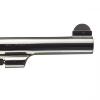gotboostvr
Member
While I can appreciate the aesthetic concern with regard to the lock holes, why isn't there equal indignation at the tasteless and hideous logo, brand, and model designation emblazoning frequently done by Ruger, Kimber and Taurus on their revolvers? At least the lock hole is small and serves a mechanical function. What function does giant, laser-etched "MATCH CHAMPION, RUGER GP-100" serve? Then there's the Super Redhawks which seem to have the entire manual printed on their side and where they chamber more than one cartridge, the barrel and the cylinder list all of them twice. At least Ruger does offer some other models with perhaps the least amount of lettering scrawled on them. Kimber's only offering has "Kimber" engraved on it at least four times, Kimber, Kimber, Kimber, Kimber, plus a giant K6S logo. Then there's the TAURUS RAGING JUDGE MAGNUM TRACKER printed in poster size apparently so near-sighted bears can make it out at 30 yards.
Hardly anybody mentions this stuff, but they're offended, they say, to the point of refusing to buy S&W because of a relatively tiny safety mechanism they say ruins the aesthetics. Maybe the hole isn't appropriate on a heavily-customized presentation piece, like a show car with shaved door handles, but if it's just a production gun, why does it matter? People aren't offended by the aesthetics. They're not offended because the feature is driven by something other than customer demand (do customers demand the read-the-manual safety warnings on most guns?). No. Their also not offended by the feature causing failures. In 20 years that just hasn't materialized as a serious concern justified by meaningful evidence. No. They're offended because they perceive the lock feature was driven by demand from their enemy.
I think the worst "bill board" was the old TSW S&W autos. Great guns, but so ugly I polished my slide to get rid of it on a 4556TSW I had




